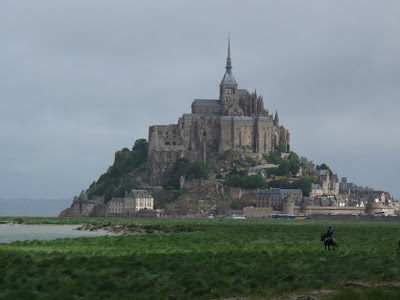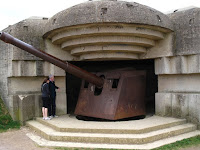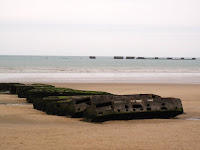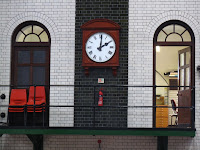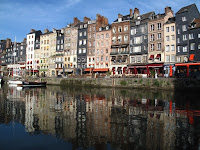

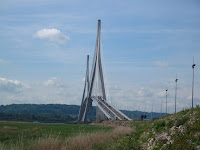 After admiring Honfleur in the sunlight, we set out over the Pont de Normandie, which until 2004 was the longest cable-stayed bridge in the world.It certainly is a beautiful piece of engineering. From here we headed to Eretat on the coast, to see a bridge which is totally naturally engineered.
After admiring Honfleur in the sunlight, we set out over the Pont de Normandie, which until 2004 was the longest cable-stayed bridge in the world.It certainly is a beautiful piece of engineering. From here we headed to Eretat on the coast, to see a bridge which is totally naturally engineered.  The headland has been likened to an elephant, and there is a great picnic spot on the cliffs overlooking both the 'elephant' and the very attractive town.
The headland has been likened to an elephant, and there is a great picnic spot on the cliffs overlooking both the 'elephant' and the very attractive town.The last stop before Calais, was further up the coast at Fecamp, where a Benedictine Monastery used to make a special liqueur with 27 different herbs and spices.
 The recipe was rediscovered in the 19th century by Alexander Le Grand, who built a grand palais as his distillery and showcase for his collection of antiquities. The display is beautifully laid out, the antiquities as presented by Alexander, and the making of Benedictine is a fragrant and very visual display of all the herbs and spices and where they originate. After looking at the distillery, the final stop is a tasting of the product.
The recipe was rediscovered in the 19th century by Alexander Le Grand, who built a grand palais as his distillery and showcase for his collection of antiquities. The display is beautifully laid out, the antiquities as presented by Alexander, and the making of Benedictine is a fragrant and very visual display of all the herbs and spices and where they originate. After looking at the distillery, the final stop is a tasting of the product.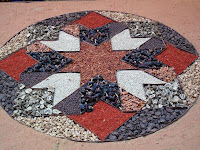 We then reached Calais in good time and joined the queue for passport control. The queue was not as daunting as Dover, but took twice as long to get to the head of our queue. Consequently we presented our passports a mere five minutes before sailing time. But due to the congestion, the boat sailed 30 minutes late, so we were able to make it in time.
We then reached Calais in good time and joined the queue for passport control. The queue was not as daunting as Dover, but took twice as long to get to the head of our queue. Consequently we presented our passports a mere five minutes before sailing time. But due to the congestion, the boat sailed 30 minutes late, so we were able to make it in time.
